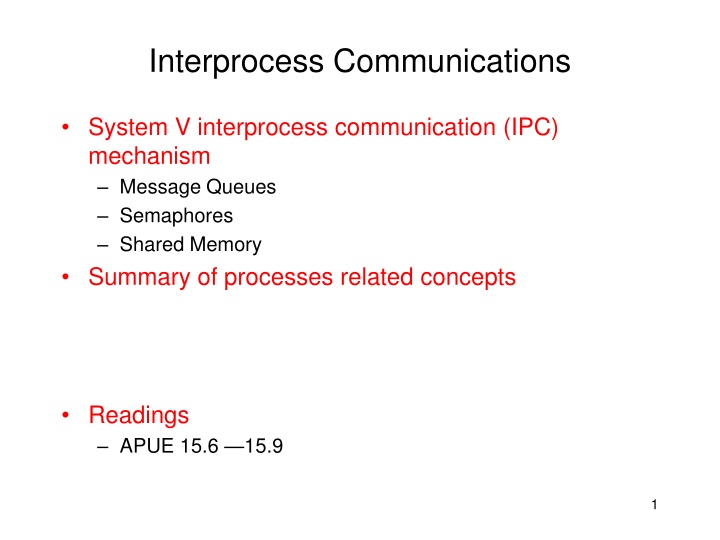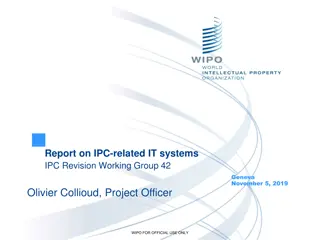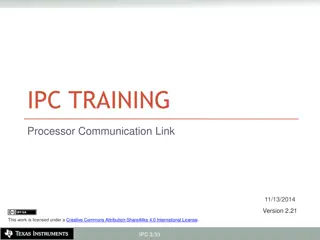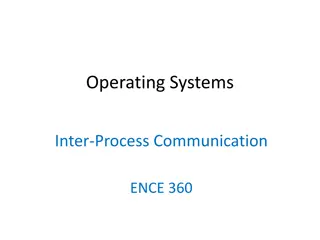
Message Queues in Interprocess Communication (IPC)
"Explore the concept of message queues in IPC, where tagged messages allow efficient data transfer, creation, operations, and more. Learn about key functions and benefits."
Download Presentation

Please find below an Image/Link to download the presentation.
The content on the website is provided AS IS for your information and personal use only. It may not be sold, licensed, or shared on other websites without obtaining consent from the author. If you encounter any issues during the download, it is possible that the publisher has removed the file from their server.
You are allowed to download the files provided on this website for personal or commercial use, subject to the condition that they are used lawfully. All files are the property of their respective owners.
The content on the website is provided AS IS for your information and personal use only. It may not be sold, licensed, or shared on other websites without obtaining consent from the author.
E N D
Presentation Transcript
Interprocess Communications System V interprocess communication (IPC) mechanism Message Queues Semaphores Shared Memory Summary of processes related concepts Readings APUE 15.6 15.9 1
Why Other IPC Mechanisms File: slow Pipes/sockets FIFO semantics Signals: sending flags Sometimes, we want something beyond FIFO FIFO with tags (message queue) File semantics: the content is always there unless it is modified explicitly (shared memory) Once concurrency is allowed in shared data, we will need a way to protect the data (lock, semaphore) All of these mechanisms are more or less difficult to use. It is by design! 2
Message Queue What is it? Similar to the FIFO pipes, except that a tag (type) is matched when reading/writing. Allowing cutting in line (I am only interested in a particular type of message) Equivalent to merging multiple FIFO pipes in one. 3
Message Queues Creating a message queue: int msgget(key_t key, int msgflag); Key can be any large number. But to avoiding using conflicting keys in different programs, use ftok() (the key master). key_t ftok(const char *path, int id); Path point to a file that the process can stat Id: project ID, only the last 8 bits are used Msgflag controls how message queue should be created Access mode What if a queue exists with the same key 4
Message Queues A linked list of messages stored within the kernel and identified by a message queue identifier. Every message has a type field, and a nonnegative length, and the actual data bytes. msgsnd puts a message at the end of the queue msgrcv gets a message, may not follow FIFO order (can be based on type) Has resource limits: MSGMAX, MSGMNB, MSGMNI, MSGTQL. 5
Message Queues Message queue operations int msgget(key_t, int flag) int msgctl(int msgid, int cmd, struct msgid_ds *buf) cmd: IPC_STAT, IPC_SET, IPC_RMID int msgsnd(int msgid, const void *ptr, size nbytes, int flag); flag: IPC_NOWAIT int msgrcv(int msgid, void *ptr, size_t nbytes, long type, int flag); type = 0: first msg in queue type > 0: first msg whose msg type == type type < 0: first msg whose msg type is lowest value <= |type| Used to have performance advantage over pipe. Performance advantage is no longer there in newer systems (compared with pipe)6
Shared Memory Common chunk of read/write memory among processes MAX Shared Memory (unique key) Create ptr ptr Attach Attach 0 Proc. 2 Proc. 1 ptr ptr ptr Proc. 4 Proc. 5 Proc. 3 7
Creating Shared Memory int shmget(key_t key, size_t size, int shmflg); Example: key_t key; int shmid; key = ftok( <somefile>", A'); shmid = shmget(key, 1024, 0644 | IPC_CREAT); See example shm_create.c 8
Attach and Detach Shared Memory void *shmat(int shmid, void *shmaddr, int shmflg); int shmdt(void *shmaddr); Example: key_t key; int shmid; char *data; key = ftok("<somefile>", A'); shmid = shmget(key, 1024, 0644); data = shmat(shmid, (void *)0, 0); shmdt(data); See example shm_attach.c 9
Deleting Shared Memory int shmctl(int shmid, int cmd, struct shmid_ds *buf); shmctl(shmid, IPC_RMID, NULL); See example shm_delete.c 10
Semaphores Managing concurrent access to shared memory segment. Using Semaphores Creation: semget( ) Incr/Decr/Test-and-set : semop( ) Deletion: semctl(semid, 0, IPC_RMID, 0); Online tutorial http://beej.us/guide/bgipc/output/html/multipage/semaph ores.html 11
Command-line IPC control ipcs Lists all IPC objects owned by the user ipcrm Removes specific IPC object 12
Process Environment Command line arguments: argc, argv environ and getenv() getpid(), getuid(), getppid() How does a program access the second (command line) argument? How does a process access the variable you set in shell using commands such as setenv TERM vt100 ? How does a process know its parent s process id? How does a parent know its children s process ids? 14
Process Management fork, exit, wait, waitpid, execv How can a parent process know whether its child has executed successfully? How to determine whether execv runs a command successfully? 15
File Operations What are the related data structures for file operations? open, close, read, write, unlink, dup. How to redirect the standard input/output/error? 16
Interprocess Communications Pipe What kind of processes can communicate with pipes? How to implement ps | grep duan | more ? Message queue Shared memory Semaphore 17
IPC Signal What is the typical default action for a signal? Blocking/unblocking a signal sigset manipulation sigfillset, sigemptyset, sigaddset, sigdelset, sigismember the sigprocmask system call Install signal handler (can ignore a signal or use default handler) signal sigaction Sending signal: kill, alarm 18
Terminal I/O canonical mode noncanonical mode tcgetattr, tcsetattr termios data structure 19
Process Group, Session, and Controlling Terminal Related to job control Who gets to access the keyboard? Who to send signal generated from the keyboard. Foreground and background processes Joining a group or creating a group: setpgid Making a group foreground or background tcgetpgrp/tcsetpgrp 20






















